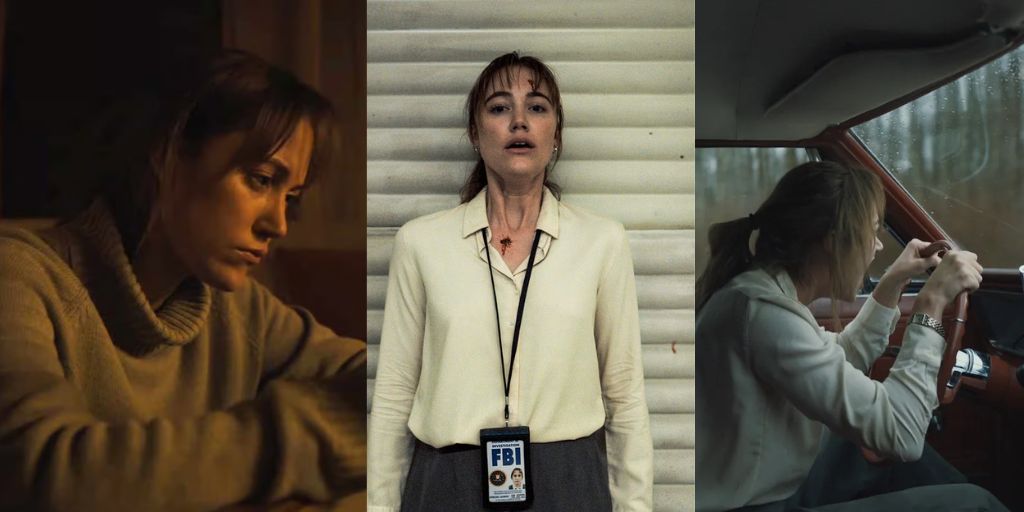Halfway through the horror-thriller “Longlegs,” written and directed by Osgood Perkins, we meet a girl who has just woken up from a long, catatonic state after a traumatic experience. When someone asks her what it was like, she says it felt like being “between here and there,” a place that is neither here nor there, like a gray, middle ground.
What makes “Longlegs” such an effective horror film—easily one of the best this year—is Perkins’ ability to make the audience feel a similar sense of uncertainty. This type of mystery is familiar, and it’s easy to compare it to movies like “Se7en” or “The Silence of the Lambs.”
But in “Longlegs,” there’s an added layer of evil that lingers throughout the film. We think we know this kind of story, but under Perkins’ direction, it’s hard to figure things out. Even as the story unfolds and we’re given clues and suspects, we struggle to make sense of it, making the whole experience unsettling from start to finish.
One of the people struggling with this uncertainty is Lee Harker (played by Maika Monroe), an FBI agent assigned to help with a serial killer case. Harker is described as “half-psychic” because she sometimes has premonitions she can’t explain.
A series of killings has been happening in Oregon for years, where ten families were found dead in their homes, murdered by their fathers without any clear reason. The suspect is someone called “Longlegs,” who leaves a birthday card at each crime scene, filled with messages like those from the Zodiac killer.
But no one knows who Longlegs is, how he makes the killings happen, or if he’s even at the crime scenes when these murders occur. All the FBI knows is that these dead families seem to be connected to Longlegs, but they don’t know how.

This case has been cold for a while, but when Harker gets involved, things start to move forward. When Longlegs leaves a birthday card at her home, she quickly figures out his code, and she easily finds patterns in the murders that her boss, Agent Carter (Blair Underwood), and the rest of the team had never noticed before.
With Harker on the case, it seems like the FBI is closer than ever to catching Longlegs, but it’s the details—the why and the how—that don’t make sense as the investigation progresses.
Perkins does a great job of making the audience feel what Harker feels as she tries to gather all the clues. This is a murder mystery where we know who the killer is right from the start. The first scene introduces us to a terrifyingly strange character played by Nicolas Cage, who is presented as Longlegs.
We know who we’re looking for—a creepy person who looks like a mix between Pennywise the clown and someone who’s really into 1970s rock. We know how these families are being killed, but how these pieces fit together is what Harker—and the audience—can’t figure out, even when we sometimes seem to be ahead of her in the investigation.
There’s a feeling that something isn’t right throughout the film, and that’s what makes Perkins’ work so effective. For most of “Longlegs,” Perkins uses medium or long camera shots, so we can look over the scene along with Harker as she searches for clues in the darkness or waits for something to step out of the shadows.
The eerie cinematography by Andres Arochi gets under your skin, even in the simplest shots, creating a sense of evil that stays with you. We’re on the case too, but like Harker, we’re not finding the answers. By leaving empty spaces in the frame, Perkins makes us feel like something evil is just out of sight, ready to strike.
Because of this approach, “Longlegs” builds a tension that never breaks, making it a “scary” film that is more about a growing worry than actual scares. But it takes some time for “Longlegs” to find its own style. This is a slow-burn film told in three chapters, and like the mystery itself, it doesn’t completely come together until the final chapter.
In the first chapter, with some quick cuts and jump scares, it can feel more like a horror-themed TikTok video than a film by Jonathan Demme or David Fincher.

For example, in the first scene where we meet Longlegs, the scene ends suddenly, trying to surprise the audience right away, before the opening credits expand on the screen, mixed with strange images to make us feel uneasy.
Sometimes, “Longlegs” relies on cheap scares like this, and it’s never as effective as the tension Perkins builds later. The more traditional scares, especially in the first half of the film, try to shock the audience, but they rarely succeed.
Perkins’ approach is more about creating a mood that sticks with you, making you feel like something is off—and it is, as we’ll soon find out. For most of the film, it’s not the story itself that’s haunting, but how Perkins tells it. A quick change in camera angle or the way he edits a scene is what really makes us uncomfortable, not the story of Longlegs itself.
As the film goes on and the mystery starts to unravel, it all shifts into something much more effective as the true evil is revealed. It’s no surprise that this is where “Longlegs” is at its best. Once the details of the case are clear, it makes watching the film again even more terrifying.
While “Longlegs” may feel like a twist on murder mysteries we’ve seen before, it also does an excellent job of creating characters who are different from the usual ones we see in these types of movies. After roles in films like “It Follows” and “Watcher,” Maika Monroe once again shows her talent in horror.
Her role as Agent Harker is very inward, as neither she nor we fully understand her “gifts,” and much of her performance relies on her confusion about what’s happening in the case and within herself. Monroe is restrained and uneasy, and following a character like that for most of the film makes us feel her anxiety and worry.
Blair Underwood’s Agent Carter is more like the type of agent we expect to see in a murder thriller like this, full of clichés and slightly funny one-liners. But he’s a regular cop thrown into an unusual mystery with no easy answers, which again plays into the idea that things aren’t as they should be.
We’ve seen this type of character in straightforward films, but this is definitely not where he belongs. Alicia Witt is also almost unrecognizable as Harker’s mother, Ruth. At first, she seems like a typical worried mother on the phone, but she becomes something much more interesting when we finally meet her. It’s a small role, but it’s unforgettable.
And then there’s Nicolas Cage as Longlegs. Much like his recent work in films like “Dream Scenario,” “Mandy,” and “Pig,” “Longlegs” knows exactly how to use Cage and his ability to handle both quiet and loud scenes. This is a flamboyant and strange character, and thankfully, Perkins uses him sparingly.

We don’t need much of Longlegs to feel his impact on the story, and Perkins rarely shows him fully, often hiding his face with the frame, his own hands, or by showing him from a distance. A little bit of Longlegs goes a long way—but Cage finds just the right way to play this twisted, odd person in a way that feels both otherworldly and disturbingly real.
Even though “Longlegs” eventually finds its footing in the slow-burn mystery filled with uncertainty, it’s in that third chapter where the film truly comes together. As the answers start coming and the true nature of this evil becomes clear, that knowledge only makes the story even more terrifying.
Making us uncomfortable through unpredictability is one thing, but keeping the horror just as effective once we know the truth is even more important. Perkins manages to make the truth just as upsetting as what we had imagined, which is a satisfying payoff that almost makes you want to watch it again immediately to see the whole story—if you could handle a “Longlegs” double feature.
While Perkins has made horror films before, “Longlegs” feels like him truly finding his style in the genre. It’s an uneasy, relentless nightmare that we can’t escape, even if it takes a while to get there. “Longlegs” takes some time to settle into its brand of horror, but once it does, it’s hard not to be impressed by the place “between here and there” where we find ourselves.
As Longlegs reaches its final chapter, the true nature of the horror is revealed, delivering a chilling and satisfying conclusion. Perkins’ mastery of mood and tension makes this film an unforgettable experience. The unsettling atmosphere lingers long after the credits roll, leaving viewers haunted by the mysteries “between here and there,” and eager to reveal its secrets once more.




